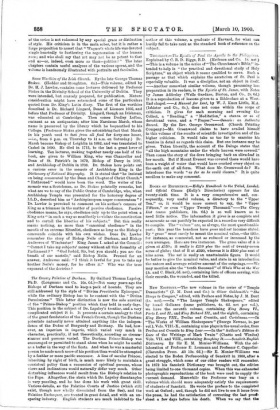Taeotoov.—The Epistle of Paul the Apostle to the Philippitas. Explained
by C. R. D. Biggs, B.D. (Methuen and Co. Is. net.) —This is a volume in the series of "The Churchman's Bible," in- tended to help in "the practical and devotional study of Holy Scripture," an object which it seems qualified to serve. Such a passage as that which explains the asceticism of St. Paul is especially valuable. It was a discipline, not an object in itself. —Another somewhat similar volume, though presoming less preparation in its readers, is The Epistle of St. James, with Notes by James Adderley (Wells Gardner, Marton, and Co., 2s. 6d.) It is a reproduction of lessons given to a Bible-class at a West. End chapeL —d Manua/ for Lent, by W. J. Knox Little, MA. (Isbister and Co., 6s.), does not -come within the scope of criticism. It gives for each morning and evening the Collect, a " Reading," a "Meditation," a stanza or so of devotional verse, and a " Prayer."—Genevis: an Authentic Record. By the Rev. George Greenwood. (Church Printing Company.)—Mr. Greenwood claims to have availed himself in this volume of the results of scientific investigation and of the higher criticism. It would take us too far to examine his treatise in detail as regards this claim. But one instance may be given. Taken literally, the account of the Deluge states that " all the high mountains under the whole heaven were covered." Then comes the story of the dove bringing back an olive-leaf in her mouth. But if Mount Everest was covered there would have been a weight of water that would have crushed every object on the earth out of all form. What does Mr. Greenwood do ? He introduces the words "as far as he could discern." It is quite needless to make any comment.






































 Previous page
Previous page